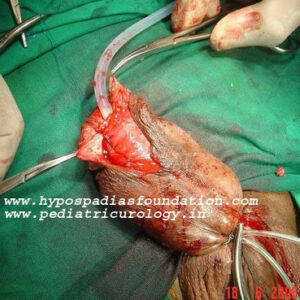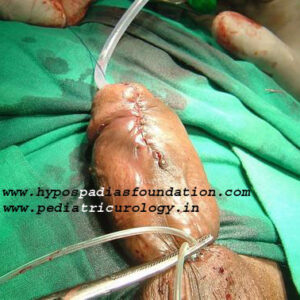A.D, a 24 years old young man had a failed hypospadias repair (elsewhere) at the age of 4 years and at present he came to us with multiple issues:
• Passage of urine from multiple holes on the underside of penis
• Persistent mild chordee
• Unsightly skin bridges and scarring on underside of penis.
On examination- the above findings were confirmed (pic1).
A single stage repair was planned. As a first step- the whole of terminal unhealthy urethra was laid open till the last hole and scarred skin and tracts were excised. A novel flap based on dartos was designed from the lateral aspect in sub-glanular region and this was flipped horizontally as an ONLAY flap (Jordan’s flpa) to make a neourethra. At the same time a 12 O’clock tunical plication was done to correct the mild chordee.
Post-op the healing was very good and at present A.D. is passing urine in good stream and has absolutely straight erections. He is extremely satisfied with the functional and cosmetic outcome.
According to his father- he has gained a new confidence and outlook ever since he has started feeling normal about his sexual organs.

Clinical picture with probe in place showing multiple holes (fistulae) in distal urethra

Island flap from nearby healthy skin (Jordan’s flap)

Flap sewn into place thus completing the urethroplasty

Completed urethroplasty in one stage
Dr Singal and Dr Dubey have an extensive experience in dealing with re-operative hypospadias who have failed surgery elsewhere. The various innovative techniques used are:
1. Parameatal flap
2. Transverse island flaps from nearby skin
3. Dorsal flaps rotated ventrally
4. Buccal mucosal patches/ grafts
Even in the face of falied multiple surgeries, an attempt is made to repair with a single stage flap surgery. Sometimes when the tissues are really scarred and unhealthy, a staged repair is offered which includes excision of the unhealthy tissue in first stage with buccal mucosa grafting and then tubularisation in the second stage.
